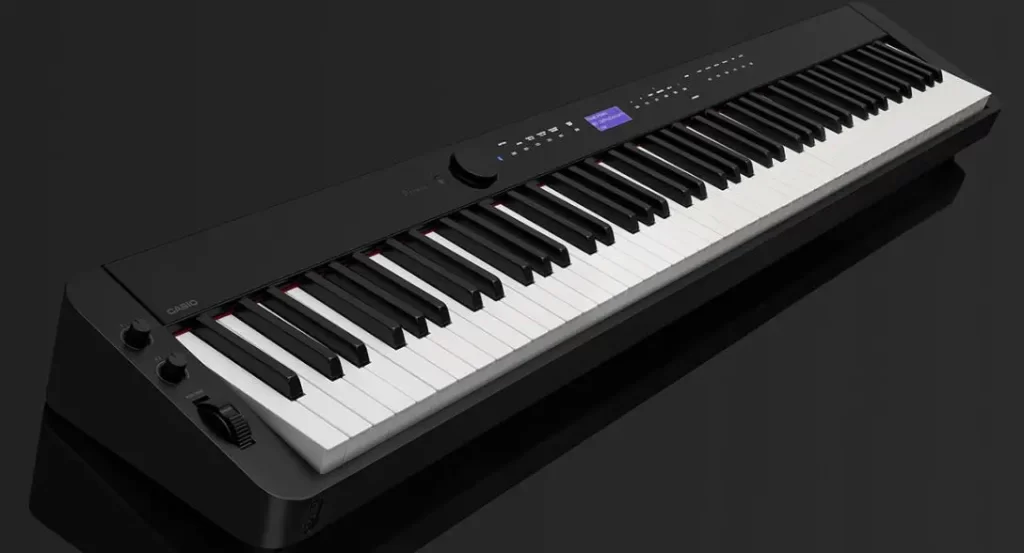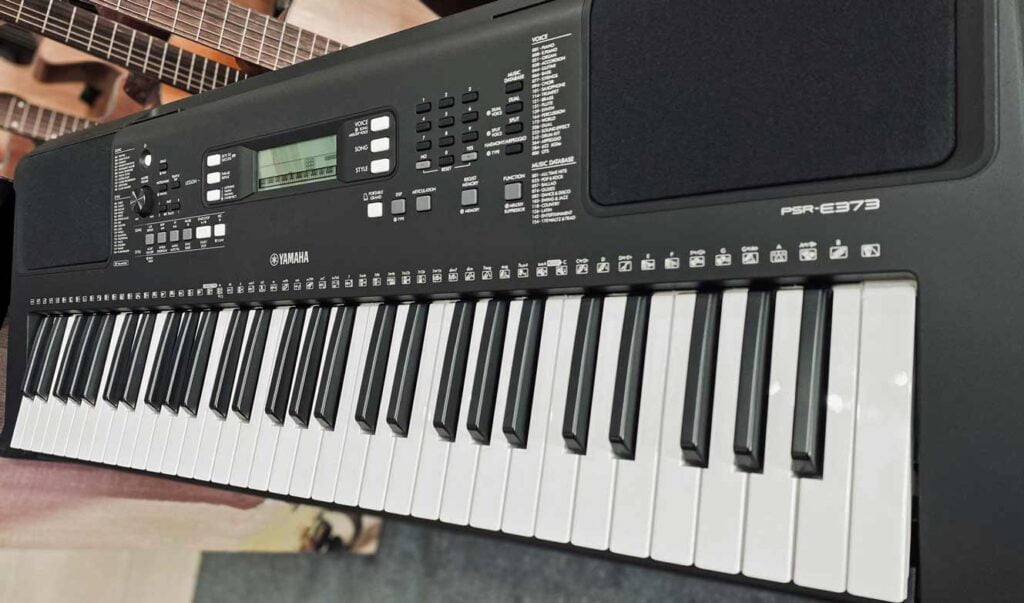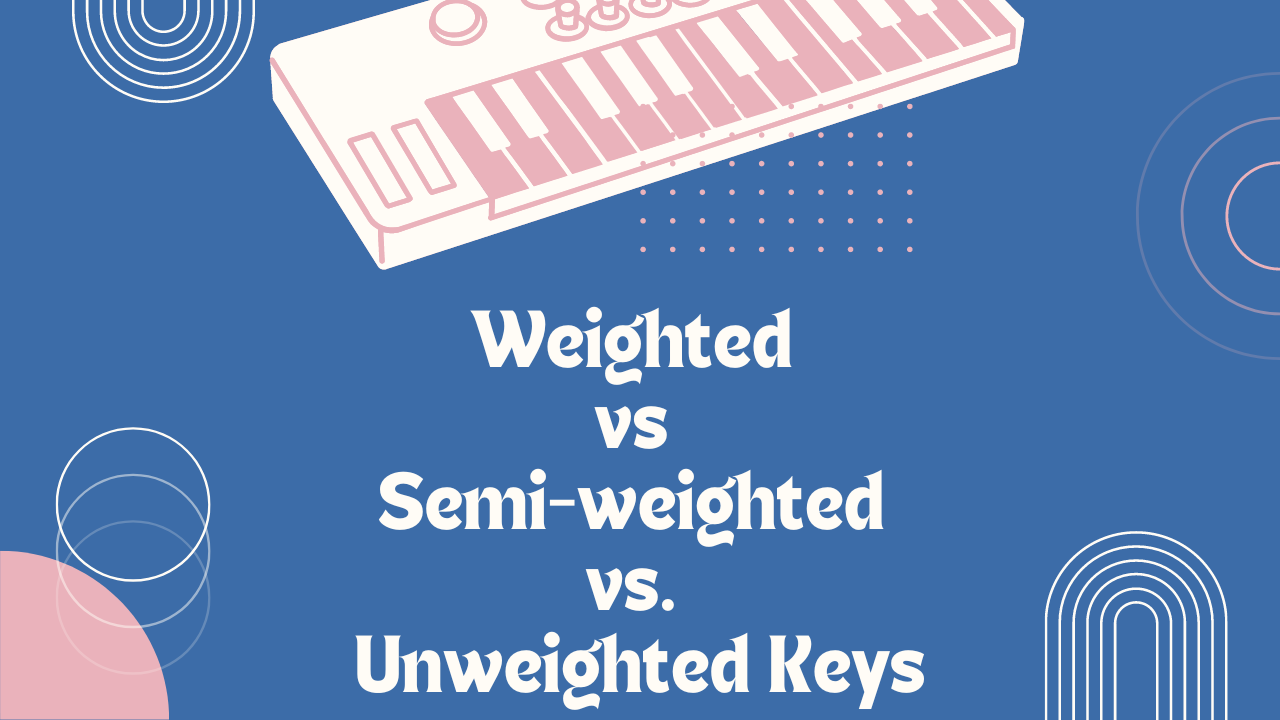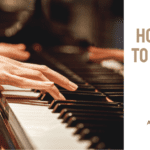When choosing a digital piano or keyboard, one of the most important factors to consider is the type of key action. The three most common types of key actions are weighted, semi-weighted, and unweighted keys. This article will explore the differences between these key types, their pros and cons, and help you determine which option is best for your playing style and skill level.
Weighted Keys
Weighted keys aim to replicate the feel of an acoustic piano by adding resistance to the keys. The resistance comes from a hammer-like mechanism, which creates a more realistic playing experience. Some digital pianos, like the Yamaha Arius YDP-165B, even use graded hammer action, which means the lower keys have more resistance than the higher keys, just like on an acoustic piano.

Pros:
- Offers a realistic playing experience similar to an acoustic piano
- Helps build finger strength and technique
- Suitable for advanced players and classical music
Cons:
- Generally more expensive than other key types
- Can be heavy and less portable
Semi-weighted Keys
Semi-weighted keys strike a balance between weighted and unweighted keys. They use a lighter mechanism than weighted keys, offering some resistance but not as much as a fully weighted key. Many players find semi-weighted keys to be a great middle ground, providing a more authentic playing experience than unweighted keys without the heaviness of fully weighted keys. The Casio Privia PX-S3000 is an example of a digital piano with semi-weighted keys.

Pros:
- Offers a moderate level of resistance
- Suitable for a variety of playing styles and genres
- More affordable than fully weighted keys
Cons:
- May not provide enough resistance for advanced players or classical music
- Not as realistic as fully-weighted keys
Unweighted Keys
Unweighted keys, also known as synth-action or non-weighted keys, are the lightest of the three key types. They use springs to provide resistance, which results in a faster key return and a lighter feel. Unweighted keys are commonly found on entry-level keyboards, such as the Yamaha PSR-E373 and EW-310, and synthesizers like the Korg MicroKorg.

Pros:
- Lightweight and highly portable
- Ideal for fast-playing styles and electronic music
- Generally the most affordable option
Cons:
- May not provide enough resistance for advanced players or classical music
- Less realistic than weighted or semi-weighted keys
Touch Sensitivity
Touch sensitivity, also known as velocity sensitivity, is an essential feature to consider when choosing a digital piano or keyboard. It refers to the responsiveness of the keys to the force applied by the player. In other words, the harder you press a key, the louder the sound, and vice versa.
Many digital pianos and keyboards offer adjustable touch sensitivity levels to accommodate various playing styles and preferences. This feature allows you to customize the responsiveness of the keys according to your comfort level and skill. There are usually three or four sensitivity settings to choose from:
- Light: Ideal for players who prefer a lighter touch, making it easier to produce louder sounds with minimal force.
- Medium: This setting provides a balanced touch sensitivity, suitable for most players and playing styles.
- Heavy: Designed for players who prefer a heavier touch, requiring more force to produce louder sounds. This setting is closer to the feel of an acoustic piano.
- Fixed: No touch sensitivity, meaning all notes produce the same volume regardless of how hard the keys are pressed. This setting is not recommended for serious players, as it limits expressiveness and dynamics.
When trying out digital pianos or keyboards, pay attention to the touch sensitivity settings and how they affect the playing experience. If possible, try adjusting the sensitivity levels to find the setting that feels most comfortable and natural for you.
Keep in mind that transitioning between different touch sensitivity settings might require some practice and adjustment. It’s worth noting that the touch sensitivity is closely related to the key action type (weighted, semi-weighted, or unweighted keys). Therefore, when choosing your ideal key action, consider the touch sensitivity options available and how they can enhance or complement your playing experience.
Key Count
The number of keys on a digital piano or keyboard plays a significant role in the playing experience and can impact your choice of key action. Digital pianos and keyboards come in various key counts, with the most common being 88, 76, 61, and 49 keys. Each key count has its benefits and is suited for different skill levels and playing styles.
88 Keys: A full-sized digital piano or keyboard with 88 keys replicates the range of an acoustic piano, making it the ideal choice for professional players, advanced students, and those who play classical music. The majority of weighted and semi-weighted digital pianos feature 88 keys, providing the most authentic playing experience. Examples of 88-key digital pianos include the Yamaha P-125 and the Roland FP-30X.
76 Keys: A 76-key digital piano or keyboard offers a slightly smaller range than a full-sized instrument, making it more compact and portable. These keyboards are suitable for intermediate players and those who require a broader range of notes than a 61-key instrument but don’t need the full 88 keys. Keyboards with 76 keys often feature semi-weighted or unweighted key actions, such as the Yamaha PSR-EW310.
61 Keys: Keyboards with 61 keys are popular among beginners and casual players due to their smaller size, portability, and lower price point. These instruments typically feature unweighted or semi-weighted keys, making them suitable for learning basic keyboard skills and playing various genres, excluding those that require a broader range of notes. Examples of 61-key keyboards include the Yamaha PSR-E373 and the Casio CTK-3500.
49 Keys: The smallest of the key counts, 49-key keyboards, are typically used for MIDI controllers or compact synthesizers. They are ideal for those who need a highly portable instrument for music production or performance. Keyboards with 49 keys generally feature unweighted keys, making them better suited for electronic music and non-classical genres. Examples include the Akai MPK Mini Mk3 and the Novation Launchkey 49.
When choosing the right key count for your digital piano or keyboard, consider your skill level, playing style, and musical preferences. For classical music and advanced players, an 88-key instrument with weighted keys is the best choice. If you’re a beginner or looking for a more portable option, a 61 or 76-key keyboard with semi-weighted or unweighted keys might be more suitable. For those who focus on electronic music or music production, a 49-key keyboard or MIDI controller with unweighted keys would be ideal.
Which is Best for You?
When choosing between weighted, semi-weighted, and unweighted keys, consider your skill level, playing style, and musical preferences. For classical music and advanced players, weighted keys are the best choice, as they provide the most realistic playing experience. Semi-weighted keys are suitable for those who play a variety of genres and styles or those looking for a more affordable option.
Unweighted keys are ideal for beginners, those on a tight budget, or players who focus on electronic music and synthesizers. Ultimately, the best way to decide which key type is right for you is to try them out for yourself. Visit a local music store or browse our best digital pianos for under $1,000 and best digital pianos for beginners under $500 lists to find a selection of digital pianos and keyboards with various key actions.
Play each type of key action and pay attention to how they feel, how they respond to your touch, and how comfortable you are playing them. Keep in mind that some digital pianos also offer adjustable key sensitivity, allowing you to customize the feel of the keys to your preference. Models like the Roland FP-60X and Yamaha P125 come with this feature, providing you with additional flexibility in finding the perfect key action for your playing style.
In conclusion, choosing the right key action is crucial for ensuring a comfortable and enjoyable playing experience. By understanding the differences between weighted, semi-weighted, and unweighted keys, you can make an informed decision that best suits your skill level, playing style, and musical preferences. Don’t forget to try out different key actions in person and explore our recommended digital pianos and keyboards to find your perfect match.





